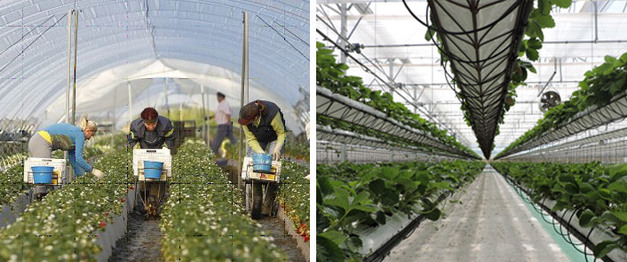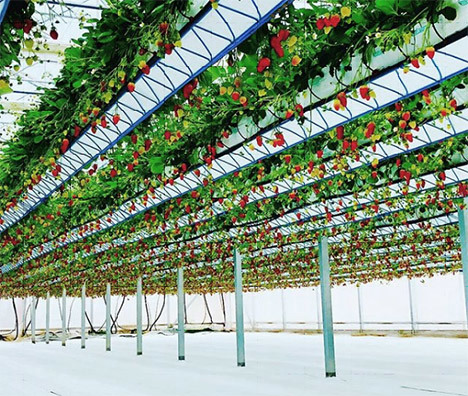Due to growing demand and challenges in cultivation and labour, more and more former open field strawberry growers have shifted to hydroponic or semi-hydroponic cultivation over the last couple of years. Next step for these growers is to lift their growing system in order to improve the working conditions, irrigation possibilities and to lower the disease pressure. “The growing interest in the market in the berry range has pushed the industry to create new tools and production systems that years ago were unthinkable, thus creating a large decrease in labor costs”, says Isabel Ruis with Hydroponic Systems.

Growing production
The global production of strawberries has grown exponentially over the last decades. Especially in Europe, the acreage has increased by almost 50%. According to the numbers of trade maps also the Northern and Central American production has grown by almost 30 per cent. “This huge development has been caused by the strong increase in demand, as strawberries are considered a fruit with a high content in vitamin C, almost equal to Citrus fruits”, says Isabel. The Spanish company has specialized in offering efficient solutions for hydroponic cultivation. “In Spain, around 93 to 95% of the production of the strawberry acreage can be found in the province of Huelva. This production is mostly destined for the European markets. The demand for higher quality and production urged growers to invest in the growing conditions and techniques, aiming at efficient use of resources, so to minimize the impact on the environment’, says Isabel.
She explains how in traditional ways of growing, where simple structures are used to protect the crop and there’s hardly any control over the climate, there’s also little control over the water and nutrients dosage and costs. “Irrigating strawberries is especially complicated because the crop is often grown under plastic, on very sandy soils with low capacity to retain water. Leaking of the water into the soil and contamination risks also caused criticism on the cultivation, especially from an environmental point of view.” In addition and especially important nowadays the plants being grown at soil level provide a problem for the labour force: the uncomfortable work makes it harder to find workers.

Semi-hydroponic as first step
Over the last years, many growers invested in a semi-hydroponic system: growing in substrates placed on the soil. “The need to rotate crops, developed mainly by family farmers in small areas, has encouraged the investigation of new forms of growth to meet the requirements of today’s markets. Since hydroponic growing can be done at any location, this can also occur close to distribution points and consumption points, therefore, saving on shipping and environmental contamination", Isabel explains.
Now they see how more and more growers chose to elevate their cultivation since it offers better control over the crop, a new opportunity to maximize production in lesser surface and reduce the use of resources further.
Up in the air
Standing or hanging systems have proven to be a solution for further development. The Elevated Hydroponic System, developed by Hydroponic Systems, has been one of the solutions enabling growers to do so. “By elevating the crop, the disease pressure is lowered so the use of chemicals will decrease. And thanks to elevating the crop, the working conditions are way better: more comfortable and more efficient. A reduction of at least 50% for the harvest costs is within reach thanks to these improved and optimized working conditions. And we can higher the production per square meter”, adds Isabel. “This is thanks to the improved growing conditions and to the higher planting density. By lifting the plants, we can grow up to 200.000 plants per hectare.’
She shows how lifting the crop will also reduce the contamination of the soil and leaking of water, making disinfection of the soil and deep fertilizing unnecessary. “The water is used more efficiently and growers get the opportunity to recirculate the drain water. To realize this and guarantee optimal use of water and nutrients, Hydroponic Systems created the spacer piece. This is a plastic gutter system which is used in many greenhouse operations which place their substrate slabs at surface level. The spacer results in better ventilation between the drain channel and the substrate with a reduction of disease pressure and a healthier root system as result.
Uniform soil
“With this relatively simple solution, the soil is irrigated in a uniform manner, allowing a uniform development of the roots of the strawberry plants. It will result in a better quality of the roots since they deal with fewer diseases as the soil is aired better and the roots aren’t in contact with the drainages. This will reduce the need to apply chemical products”, Isabel says. “And it will result in better performance of the crop: the fruits will benefit from the better nutritional control and both the cultivation quality as the quantity will improve thanks to this.”
“As we can see, the growing interest in the market in the berry range in the last years has made the industry create new tools and production systems that years ago were unthinkable”, Isabel concludes. “Very important in this is also the reduction in labor costs, which is difficult and expensive to find due to the working conditions of working at ground level. According to “Revista Mercados” in their article on the 02/2019 about the collection of strawberries, in the year 2019 23,000 positions were offered for workers to collect strawberries in Huelva, having only 970 people replied and showed interest, this figure is only 4.2% of the unemployed people registered in this area, showing a lack of interest in a province with 25% unemployment. The development of systems like Hydroponic Elevated Systems permit the growers to be more efficient while investing in quality and production: answering the market demand.”
Hydroponic Systems
Murcia, Spain
info@hydroponicsystems.es
+34 968 89 81 81
www.hydroponicsystems.eu
